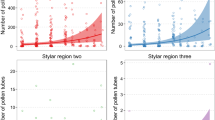Summary
A direct measure of pollinator effectiveness, relying on seed set, is proposed, where:
P i =mean number of seeds set/flower by a plant population receiving a single visit from species i
Z=mean number of seeds set/flower by a population receiving no visitation.
U=mean number of seeds set/flower by a population receiving unrestrained visitation.
The utility and limitations of the proposed measure are discussed and exemplified with a population of Ipomoea trichocarpa (Convoculaceae)
Similar content being viewed by others
References
Alderz WC (1966) Honeybee visit numbers and watermelon pollination. Journal of Economic Entomology 59:28–30
Baker HG, Hurd PD (1968) Intrafloral ecology. Annual Review of Entomology 13:385–414
Barrows EM (1976) Nectar robbing and pollination of Lantana camara (Verbenaceae). Biotropica 8:132–135
Beattie AJ (1972) The pollination ecology of Viola, 2. Pollen loads of insect visitors. Watsonia 9:13–25
Charnov EL (1979) Simultaneous hermaphroditism and sexual selection. Proceedings of the National Academy of Sciences 76:2480–2484
Collison CH, Martin EC (1979) The relationship of foraging activity to fruit set and shape in the pollination of pickling cucumbers, Cucumis sativus. Proceedings of the Fourth International Symposium on Pollination. Maryland Agricultural Experimental Station Special Publications 1:183–188
Eaton GW, Daubeny HA, Norman RC (1967) Pollination techniques for red raspberry breeding programs. Canadian Journal of Plant Sciences 48:342–344
Ehrenfeld JG (1979) Pollination of three species of Euphorbia subgenus Chamaesyce, with special reference to bees. American Midland Naturalist 101:89–98
Faegri K, Pijl L van der (1979) Principles of pollination ecology. 3rd edition, revised. Pergamon Press, Oxford
Galen C, Kevan PC (1980) Scent and color, floral polymorphism and pollination biology in Polemonium viscosum. American Midland Naturalist 104:282–289
Grant V, Grant KA (1965) Flower pollination in the Phlox family. Columbia University Press, New York
Gregory DP (1963) Hawkmoth pollination in the genus Oenothera. Aliso 5:357–384
Gregory DP (1964) Hawkmoth pollination in the genus Oenothera. Aliso 5:385–419
Hartling LK, Plowright RC (1979) An investigation of inter- and intra-inflorescence visitation rates by bumblebees on red clover with special reference to seed set. Proceedings of the Fourth International Symposium on Pollination. Maryland Agricultural Experimental Station Special Publications 1:457–460
Janzen DH (1977) A note on optimal mate selection by plants. American Naturalist 111:365–371
McDade LA, Kinsman S (1980) The impact of floral parasitism in two neotropical, hummingbird pollinated species. Evolution 34:944–958
McGregor SE, Levin MD, Foster RE (1965) Honeybee visitors and fruit set in cantaloups. Journal of Economic Entomology 58:968–970
Miller RB (1981) Hawkmonths and the geographic patterns of floral visitation in Aquilegia caerulea. Evolution 35:763–774
Motten AF, Campbell DR, Alexander DE, Miller HL (1981) Pollination effectiveness of specialist and generalist visitors to a North Carolina population of Claytonia virginica. Ecology 62:1278–1287
Parker FD, Hatley CL (1979) Onion pollination: Viability of onion pollen and pollen diversity on insect body hairs. Proceedings of the Fourth International Symposium on Pollination. Maryland Agricultural Experimental Station Special Miscellaneous Publications 1:201–206
Primack RB, Silander JA Jr (1975) Measuring the relative importance of different pollinators to plants. Nature 255:143
Rust RW (1979) Pollination of Impatiens capensis: Pollinators and nectar robbers. Journal of the Kansas Entomological Society 52:297–308
Stephenson AG (1979) An evolutionary examination of the floral display of Catalpa speciosa. Evolution 33:1200–1209
Stephenson AG (1980) Fruit set, herbivory, fruit reduction, and the fruiting strategy of Catalpa speciosa. Ecology 61:57–64
Tepedino VJ (1981) The pollination efficiency of the squash bee (Peponapis pruinosa) and the honey bee (Apis mellifera) on summer squash (Cucurbita pepo). Journal of the Kansas Entomological Society 54:359–377
Waser NM (1978) Competition for hummingbird pollination and sequential flowering in two Colorado wildflowers. Ecology 59:934–944
Willson MF (1979) Sexual selection in plants. American Naturalist 113:777–790
Author information
Authors and Affiliations
Rights and permissions
About this article
Cite this article
Spears, E.E. A direct measure of pollinator effectiveness. Oecologia 57, 196–199 (1983). https://doi.org/10.1007/BF00379581
Received:
Issue Date:
DOI: https://doi.org/10.1007/BF00379581




